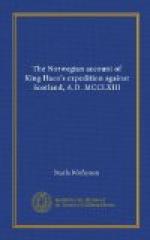King Haco had given orders that his remains should be carried east to Norway, and buried near his Father and relations. Towards the end of winter, therefore, that great vessel which he had had in the west was launched, and soon got ready. On Ash-Wednesday the corpse of King Haco was taken out of the ground; this happened on the third of the nones of March. The Courtiers followed the corpse to Skalpeid where the ship lay, and which was chiefly under the direction of Bishop Thorgisl, and Andrew Plytt. They put to sea on the first Saturday in Lent; but meeting with hard weather, they steered for Silavog.[104] From this place they wrote letters to Prince Magnus acquainting him with the news, and then set sail for Bergen. They arrived at Laxavog[105] before the festival of St. Benedict.[106] On that day Prince Magnus rowed out to meet the corpse. The ship was brought near to the King’s palace; and the body was carried up to a summer house. Next morning the corpse was removed to Christ-church, and was attended by Prince Magnus, the two Queens, the Courtiers, and the town’s people. The body was then interred in the Choir of Christ-church; and Prince Magnus addressed a long and gracious speech to those who attended the funeral procession. All the multitude present expressed great sorrow of mind as Sturlas says.
22.
Three nights did the brave warriors, the flower of chivalry, continue at Bergen, ere they entombed their wise and glorious Prince. The breakers of temper’d metals, stood crowding around the grave of the ruler of the nation, while in their swimming eyes appear’d no look of joy.—Then commenced those bloody feuds which till our days have reigned.
King Haco was buried three nights before the festival of the annunciation of the Virgin Mary; and after the Incarnation of our Lord Jesus Christ one thousand two hundred and sixty three years.[107]
Finis.
FOOTNOTES:
[Footnote 1: Sudr-eyiar, (orig.). The Hebrides or southern division of the Scottish islands, so called in contradistinction to the Orkneys.]
[Footnote 2: Godred, Chrou-ban, i.e. the white handed, King of Man.]




